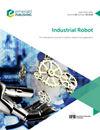Tightly coupled IMU-Laser-RTK odometry algorithm for underground multi-layer and large-scale environment
IF 2.5
4区 计算机科学
Q3 ENGINEERING, INDUSTRIAL
Industrial Robot-The International Journal of Robotics Research and Application
Pub Date : 2023-09-07
DOI:10.1108/ir-11-2022-0281
引用次数: 0
Abstract
Purpose The purpose of this study is to designed a robot odometry based on three dimensional (3D) laser point cloud data, inertial measurement unit (IMU) data and real-time kinematic (RTK) data in underground spatial features and gravity fluctuations environment. This method improves the mapping accuracy in two types of underground space: multi-layer space and large-scale scenarios. Design/methodology/approach An IMU–Laser–RTK fusion mapping algorithm based on Iterative Kalman Filter was proposed, and the observation equation and Jacobian matrix were derived. Aiming at the problem of inaccurate gravity estimation, the optimization of gravity is transformed into the optimization of SO(3), which avoids the problem of gravity over-parameterization. Findings Compared with the optimization method, the computational cost is reduced. Without relying on the wheel speed odometer, the robot synchronization localization and 3D environment modeling for multi-layer space are realized. The performance of the proposed algorithm is tested and compared in two types of underground space, and the robustness and accuracy in multi-layer space and large-scale scenarios are verified. The results show that the root mean square error of the proposed algorithm is 0.061 m, which achieves higher accuracy than other algorithms. Originality/value Based on the problem of large loop and low feature scale, this algorithm can better complete the map loop and self-positioning, and its root mean square error is more than double compared with other methods. The method proposed in this paper can better complete the autonomous positioning of the robot in the underground space with hierarchical feature degradation, and at the same time, an accurate 3D map can be constructed for subsequent research.地下多层大尺度环境下紧密耦合IMU-Laser-RTK测程算法
目的设计基于三维激光点云数据、惯性测量单元(IMU)数据和实时运动学(RTK)数据的地下空间特征和重力波动环境下的机器人里程计。该方法提高了地下空间在多层空间和大尺度场景下的成图精度。提出了一种基于迭代卡尔曼滤波的IMU-Laser-RTK融合映射算法,推导了观测方程和雅可比矩阵。针对重力估计不准确的问题,将重力优化转化为SO(3)的优化,避免了重力过参数化问题。结果:与优化方法相比,计算量减少。在不依赖轮速里程计的情况下,实现了机器人的同步定位和多层空间的三维环境建模。在两类地下空间中进行了性能测试和比较,验证了算法在多层空间和大尺度场景下的鲁棒性和准确性。结果表明,该算法的均方根误差为0.061 m,比其他算法具有更高的精度。独创性/价值基于大回路、低特征尺度的问题,该算法能较好地完成地图回路和自定位,其均方根误差比其他方法大一倍以上。本文提出的方法可以更好地完成机器人在具有层次特征退化的地下空间中的自主定位,同时可以为后续研究构建精确的三维地图。
本文章由计算机程序翻译,如有差异,请以英文原文为准。
求助全文
约1分钟内获得全文
求助全文
来源期刊
CiteScore
4.50
自引率
16.70%
发文量
86
审稿时长
5.7 months
期刊介绍:
Industrial Robot publishes peer reviewed research articles, technology reviews and specially commissioned case studies. Each issue includes high quality content covering all aspects of robotic technology, and reflecting the most interesting and strategically important research and development activities from around the world.
The journal’s policy of not publishing work that has only been tested in simulation means that only the very best and most practical research articles are included. This ensures that the material that is published has real relevance and value for commercial manufacturing and research organizations. Industrial Robot''s coverage includes, but is not restricted to:
Automatic assembly
Flexible manufacturing
Programming optimisation
Simulation and offline programming
Service robots
Autonomous robots
Swarm intelligence
Humanoid robots
Prosthetics and exoskeletons
Machine intelligence
Military robots
Underwater and aerial robots
Cooperative robots
Flexible grippers and tactile sensing
Robot vision
Teleoperation
Mobile robots
Search and rescue robots
Robot welding
Collision avoidance
Robotic machining
Surgical robots
Call for Papers 2020
AI for Autonomous Unmanned Systems
Agricultural Robot
Brain-Computer Interfaces for Human-Robot Interaction
Cooperative Robots
Robots for Environmental Monitoring
Rehabilitation Robots
Wearable Robotics/Exoskeletons.

 求助内容:
求助内容: 应助结果提醒方式:
应助结果提醒方式:


